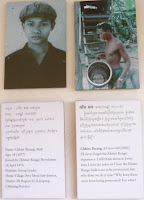Together, Anything is possible
This trip to Cambodia wasn’t all about play and fun. We actually spent more than a week restoring, rebuilding, repairing and repainting a village school and its neighbourhood which was partially destroyed during the flood just months ago. Work started as early as 5am and we slept not later than 3am. Also, a few of us were down with diarrhoea and all sorts of injuries. However, none of us lamented or complained because these were what we expected and what we wanted in order to accomplish our mission. Fortunately, we received great help from our local World Vision such that we were able to complete and contribute our little bit to the community.
Our group of 28 consists of people from all walks of life, including a doctor, students and housewives. Some of us have been donors of World Vision while some have foster Cambodian children and took this opportunity to visit them.
Many of us can have a choice not to live in poverty and despair but the Cambodians can’t. Needless to say, Cambodian children are among the most deprived and abused in the world. 19,000 street children and orphans of Cambodia are among the most desperate of the poor. Statistics show:
1. 46% of the street children are scavengers
2. 18% are beggars.
3. Approximately 9% of female are street kids.
4. About 5% of male ones are involved in prostitution.
5. About 2% of street children in Cambodia die every day from hunger or hunger-related causes.
6. The majority of hunger deaths are caused by chronic malnutrition, sickness, and disease.
How can we help the children in Cambodia?
1. Become a foster Mom or Dad.
2. Child Sponsorship. Send a fixed amount of donation per month to provide food, clothing, medicine, education and shelter.
3. Donate school supplies. For many children, an education is their only hope to escape poverty. However, many of them are not able to attend school because they lack the most basic educational tools like papers and pencils.
4. Donate medical supplies. Even people fighting to survive deserve to have the dignity and health inspired by warm clothing, shoes and personal care items. Such a gift can reaffirm a child’s worth as well as provide a practical necessity.
5. Donate personal care. Soap and clean water are one of the most effective ways of combating sickness and death for children and families living in the poorest communities around the world.
6. Donate children's toys. Every child deserves a proper childhood. No childhood is complete without toys although they may not be necessary.
At the end of the day, the ultimate goal is to see families and communities reach a point of self-sufficiency, thereby giving every child a better and healthier place to live in.
If you need more details, please contact your local World Vision Organisation.



























 <
<

 Left: cooling down exercise
Left: cooling down exercise

 Event Details: Great Eastern Women 10km 2008
Event Details: Great Eastern Women 10km 2008















 "TUOL SLENG" Museum of Genocid Crimes is in Phnom Penh, the captial of Cambodia. In the past, Tuol Sleng Museum was one of the secondary schools in the capital called "Tuol Svay Prey" high school. After the Khmer Rouge outlawed education in April 1975, the school was transformed into a prison called S21 (Security office 21) which was the biggest in Kampuchea Democratic. It was surrounded with double wall of corrugated iron, surmounted by dense barbed wire. The classrooms on the ground and the 1st floors were pierced and divided into individual cells, whereas the ones on the second floor were used for mass detention.
"TUOL SLENG" Museum of Genocid Crimes is in Phnom Penh, the captial of Cambodia. In the past, Tuol Sleng Museum was one of the secondary schools in the capital called "Tuol Svay Prey" high school. After the Khmer Rouge outlawed education in April 1975, the school was transformed into a prison called S21 (Security office 21) which was the biggest in Kampuchea Democratic. It was surrounded with double wall of corrugated iron, surmounted by dense barbed wire. The classrooms on the ground and the 1st floors were pierced and divided into individual cells, whereas the ones on the second floor were used for mass detention. The Victims’ Graves...
The Victims’ Graves... Building ‘A’ is a 3-storey building. The classrooms on the ground floor of this block had been converted into interrogation and torture cells. The upper floors were used to detain prisoners.
Building ‘A’ is a 3-storey building. The classrooms on the ground floor of this block had been converted into interrogation and torture cells. The upper floors were used to detain prisoners.






















